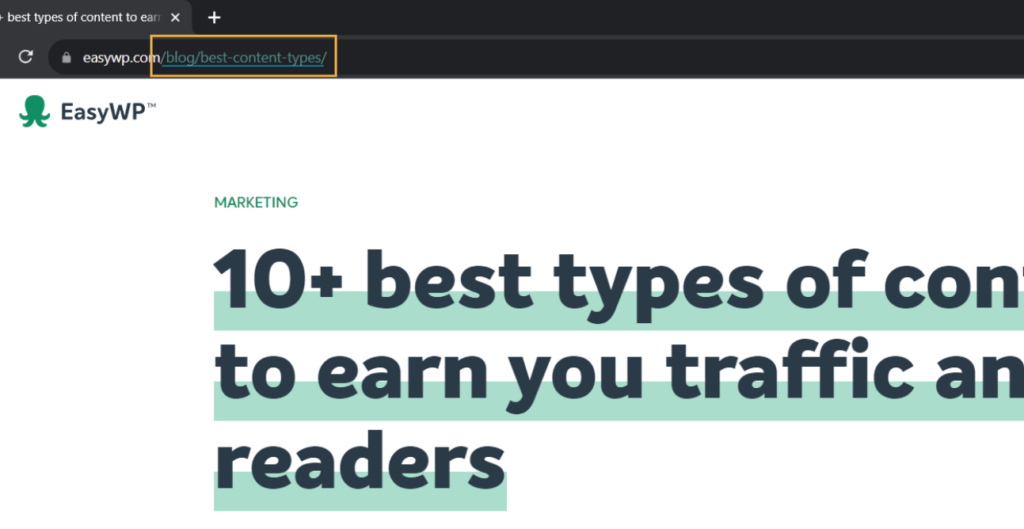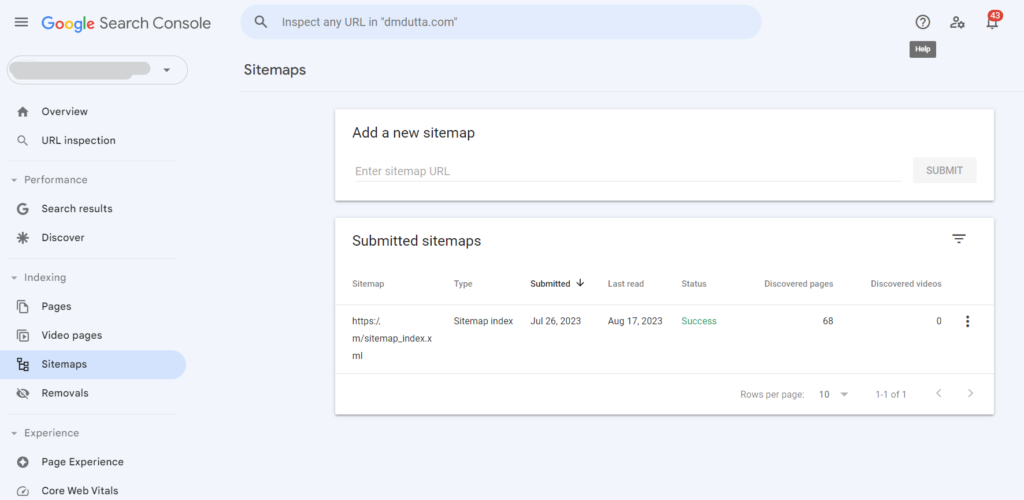7 SEO Factors to check before changing a URL slug


Although the humble URL slug may not seem important, it plays a big role in your website’s SEO.
A well-crafted slug can boost your content marketing and improve your search engine rankings. If you choose the right keyword for your slug, you’ll create a context that shows people and search engines that your content is useful. And you’ll draw more traffic and engagement.

The URL slug is the keyword set in your page URLs as highlighted in the image above.
However, if you’re considering changing URL slugs, you should proceed carefully, especially if your posts are already performing well. Changing your URL slug can affect SEO and your traffic and engagement levels.
We’ll explore the process of changing your slugs with minimal impact. Plus, we’ll discuss the critical SEO factors to consider and help you make an informed decision that supports your digital marketing strategy.
7 SEO factors to consider before changing a URL slug
Here are the key factors to look at before you make any URL slug changes.
1. Audit your content
Before making any changes, you need to conduct a comprehensive content audit to understand how your current content is performing.
Start by reviewing your website’s traffic, impressions, clicks, and other key metrics. This will establish a baseline that will help you understand the impact of any changes you might make later.

A content audit also gives you an opportunity to identify which parts of your content are already doing well and which areas might need a boost.
If your posts are already generating substantial traffic and engagement, changing the URL slug might not be necessary.
On the other hand, if the performance is low, a URL slug change might just be the kickstart that your content needs. Remember, the goal is to improve SEO performance, not disrupt it. Therefore, a content audit is a crucial first step in this process.
You can use an SEO tool such as Semrush, Ahrefs, or similar to track the traffic and positions for posts you’re changing. And over the next few weeks and months, you’ll compare how things change before and after you edit the URL slug.
2. Keyword research
In the realm of SEO, keywords are the building blocks, and your URL slug is no exception.
To ensure your slug is SEO-friendly, you should conduct meticulous keyword research. This will guide you in selecting the right keywords to include in your slug.
Keyword research tools allow you to discover the keywords your target audience uses to search for similar content. These tools also provide valuable insights into the competitiveness and search volume of these keywords.
But don’t just look at numbers. You want your URL slug to align closely with search intent.
Search intent refers to the reason why someone searches for keywords. This can be broken down into categories such as informational intent, navigational intent, and transactional intent.
Choose keywords that match the search intent of your content, so you can ensure that you’re attracting people who are looking for something specific.
For example, if your post is about the history of rap music, you don’t want to include generic keywords like ‘music’ in your slug. Instead, use a keyword that matches the search intent, such as ‘history-of-rap-music.’

That is, you want to pick a keyword that is both contextually relevant and is backed by numbers like a high search volume, low keyword difficulty, and so on.
Researching and picking the right keywords in this way not only boosts SEO but also provides potential visitors with a clear idea of what to expect from your page.
3. Use 301 redirects
When changing URL slugs, a significant concern is preserving the SEO value of the old URL. One of the most effective methods to manage this change without disrupting your SEO is to use 301 redirects.
A 301 redirect is a permanent redirect that automatically sends visitors from the original URL to the new one. This is crucial because it ensures that any traffic or links that contributed to your old URL’s SEO don’t get lost during the transition.
Consider this process as like redirecting mail in real life, where a change of address does not result in missing important mail. The postal service redirects your mail from your old address to your new one. Similarly, a 301 redirect ‘forwards’ visitors and search engines from your old URL slug to the new one, ensuring that your SEO efforts aren’t wasted.
Adding 301 redirects can be accomplished with numerous SEO tools, but the best intuitive option is AIOSEO.
AIOSEO is an SEO WordPress plugin that simplifies adding 301 redirects, making it a seamless part of your process of changing URL slugs.
Here’s a brief breakdown of using AIOSEO:
- Install and activate the AIOSEO plugin on your website.

- Navigate to the ‘Redirects’ menu in the AIOSEO settings.

- Select ‘Add Redirect’.

- Input the old URL slug and the new URL slug.
- Choose ‘301 Moved Permanent’ as the type of redirect.
By following these steps, AIOSEO will handle the redirection automatically, ensuring that traffic and SEO value flow smoothly from the old URL to the new one. Therefore, using 301 redirects is a powerful strategy to minimize the impact of changing URL slugs on your SEO.
4. Audience communication
When making changes to your URL slug, it’s helpful to keep your audience informed. This step is often overlooked, but it’s vital in minimizing disarray and maintaining your audience’s trust.
When communicating about these changes, be clear and concise to prevent misunderstandings. You don’t have to explain the technical details, but you should prime your audience to expect a few changes.
Explain the reasons for any changes and the benefits that come with it, such as improved navigation and enhanced user experience. This makes the audience a part of the journey, helping to foster their understanding and acceptance of the change.
A practical way to communicate these changes is through your email newsletters. Craft an email that explains the upcoming changes, reassuring your audience that the changes are designed to improve their experience on your website.
Customer satisfaction emails allow you to uncover issues and fix bugs faster.
You can also use social media to announce changes and link to the email or a blog post for more detailed information. Take this opportunity to open a dialogue with your audience using surveys. This can provide valuable insights, as well as make your audience feel heard and involved.
Remember, proactive communication can go a long way in ensuring that changes are accepted and understood by your audience. It helps to reduce confusion and maintain your website’s user engagement and trust levels, ultimately supporting your SEO strategy.
5. Backlink preservation
The role of backlinks in SEO is paramount. Backlinks not only help search engines like Google discover new content but also significantly contribute to building your website’s authority.
Search engines perceive backlinks as votes of confidence from other websites, thereby increasing your site’s credibility and improving its rank on search engine results. So, when you’re changing URL slugs, it’s crucial to preserve these backlinks.
A well-executed 301 redirect should take care of this by automatically directing any backlinks of the old URL to the new one. However, for key backlinks, especially those from high-authority websites, consider reaching out directly to webmasters or site owners. Politely ask them to update the backlinks with your new URL slug to avoid any potential issues.
To help with this process, you can use various SEO monitoring tools that can identify who is linking to your site. These tools will provide a comprehensive list of your backlinks, enabling you to verify if they still function correctly after changing the URL slug.

Use an SEO platform like Ahrefs to check your backlinks.
Tools like Ahrefs also let you know about ‘broken backlinks’ and ‘lost backlinks’ which should help you narrow down on issues that need a manual touch. With such data, you can quickly identify problems and take action.
6. Notify search engines
In addition to the steps mentioned above, notifying search engines about your URL slug change is a crucial step toward maintaining your SEO score. This can be done seamlessly through your XML sitemap and Google Search Console.
Your XML sitemap is essentially a roadmap of your website that leads search engines to all your important pages. Whenever you change a URL slug, it’s important to update your XML sitemap as it helps search engines quickly understand your site structure and find the updated pages.
To update the sitemap, simply remove the old URLs and add the new ones. Many website platforms like WordPress automatically update the sitemap whenever changes are made, but it’s always wise to double-check this to avoid any loose ends.
Once your sitemap is updated, you need to submit it to Google using Google Search Console. This will allow Google to crawl your new URLs faster.
Here’s a quick step-by-step guide on how to do it:
- Sign in to your Google Search Console account.
- Select your website from the property list.
- Click on ‘Sitemaps’ on the left navigation menu.
- Click on the last submitted sitemap and go to the sitemap page
- Here, you can remove the sitemap.
- Go back to Sitemaps and ‘Add a new sitemap’
- Click ‘Submit’.

Add your new sitemap in Google Search Console
By doing this, you’re essentially telling Google that your website has been updated. It’s like waving a flag to get Google’s attention. This way, Google can re-crawl your website, update its index, and continue serving your site in the search results, ensuring that your URL slug change doesn’t negatively impact your SEO.
Of course, an easier step is to just use AIOSEO and it will handle redirects, XLM sitemap creation, and updates all at once.
7. Set up guidelines for future URL slugs
To ensure your future URL slugs don’t need frequent changes, it’s essential to create a URL slug style guide and share it with your team. This guide will give your team a clear understanding of how to create effective and SEO-friendly URL slugs from the start, potentially saving you from a lot of future difficulties.
- Avoid using numbers or mentioning years in your slugs, as they can quickly become outdated and require changes. Instead, focus on creating timeless and descriptive slugs that clearly indicate the page’s content.
- Including relevant keywords in your URL slugs can also enhance your SEO as it signals to search engines what the page is about. However, avoid keyword stuffing, which can lead to penalties from search engines. Stick to one or two relevant keywords that accurately represent the page’s content.
- Keep the URL slugs short and simple. Long URLs can be hard to remember and may get cut off in search results. Aim for a maximum of three to five words in your slugs.
- Use hyphens to separate words in your URL slugs, as search engines read these as spaces. Avoid using underscores, spaces, or any other special characters as they can cause issues.
- Finally, always use lowercase letters in your URL slugs as some servers are case sensitive. This means that a URL with uppercase letters could lead to a 404 error.
By following these guidelines, you can create URL slugs that are SEO-friendly and don’t require frequent changes. Remember, consistency and clarity are key when it comes to URL slugs.
For SEO, consistency is key
In conclusion, it’s important to keep your URL slugs consistent for good SEO.
But if you do have to change them, make sure you follow the best practices shared in this post.
Remember, even the smallest details, like URL slugs, can make a big difference in the world of SEO. So, make sure you change your URL slugs in the right way.

Guest Contributor: Syed Balkhi
Syed Balkhi is the founder of WPBeginner, the largest free WordPress resource site. With over 10 years of experience, he’s the leading WordPress expert in the industry. You can learn more about Syed and his portfolio of companies by following him on his social media networks.
